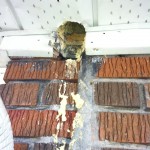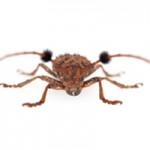Paper wasps, yellowjackets and hornets are just some of stinging insects that inhabit our planet, in some cases, an insect sting is fatal. Persons who develop breathing or swallowing issues, wheezing or similar symptoms of venom allergic reaction should seek immediate medical attention. Itching, pain and localized swelling can be reduced with antihistamines or cold/ice compress. Honey bees have a barbed stinger, only the honey bee leaves her stinger in the skin.
Yellowjackets
Yellowjackets tend to be a medium size and black with bands of bright yellow or white on the abdomen. They have a very short and narrow waist. Colonies, which have begun each spring by a single reproductive female, can reach 1000 to 10,000 in size. The wasps build nests of paper, made from wood fibres mixed with saliva. Yellowjackets are unpredictable and sting when their nest is disturbed. In late summers and fall, their colonies are about to mature and large numbers of workers go out in search of food for their developing queens. Their main source of nutrition is sweets, e.g. Fruits, ice cream, beer and soft drinks.
To reduce the threat of yellowjackets minimize use of food sources. People eating outdoors should keep their food and beverages covered. Clean up spills and put away leftovers. Commercial establishments like ice cream parlours or cafes should keep their business clean, removing trash regularly and keeping it away from serving tables and high traffic areas.
A dilute solution of ammonia and water sprayed in and around trash cans and sponged onto the outdoor tables and food preparation surfaces can repel yellowjackets. Use household ammonia not Clorox (bleach).
Paper Wasps:
Paper wasps tend to be golden brown, or darker, with large patches of yellow or red. They prefer to live in or near vineyards and orchards, the paper wasp hangs its nest in protected areas such as attics, under tree branches or other hard to reach locations. Hanging like an open umbrella, it has open cells that can be seen from beneath the nest. White, legless, grub-like larvae can be seen from below. Paper wasp nests rarely exceed the size of an outstretched hand and populations vary between 10 to 100 wasps. Paper wasps species are relatively not aggressive but can be an issue if above doorways or high traffic areas.
The nest is created from plant fibres and saliva. They are beneficial because they eat pests that harm agricultural crops. They can build their nests on almost any structure like trees, rocks, wood, playground equipment and buildings. Removal of the nest in early spring helps prevent large nesting colonies in the summer. Nest removal is dangerous and should be left up to the professionals as should any insect nest removal.



